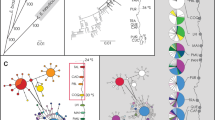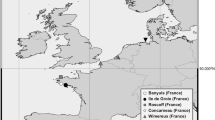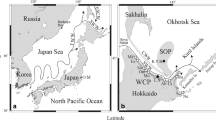Abstract
Hybridization experiments in the laboratory, performed until the F1 free-living juvenile stage, showed failure of embryonic development in crossbreedings between certain populations of mysids from meso- to metahaline waters of the Mediterranean that were previously lumped together under the name Diamysis bahirensis (G. O. Sars). Western Mediterranean populations did not successfully crossbreed with those from the eastern basin and vice versa. This is consistent with the W-E morphological differentiation in this genus and with different salinity affinities of the western as compared to the eastern forms. From the study of type material, the diagnosis of D. bahirensis is redefined to populations in the SW-Mediterranean showing large spiniform projections of the sixth pleonite, flanking the telson, and numerous small fringes on the posterior margin of the male carapace. Crossbreeding was unsuccessful with populations of D. mesohalobia n. sp. in the E-Mediterranean, which show smooth posterior margin of the carapace in both sexes and distally pectinate paradactylary setae on certain pereiopods, at least in females. Within this species, three morphotypes with different salinity affinities in nature are distinguished; as they showed successful laboratory interbreeding under mesohaline conditions, the taxa, therefore, are defined at subspecific level (D. mesohalobia mesohalobia, D. mesohalobia gracilipes n. ssp., D. mesohalobia heterandra n. ssp.). Populations of these three subspecies failed to crossbreed with a W-Mediterranean (NE-Tyrrhenian) population of D. lagunaris n. sp., which is characterized by a smooth carapace in both sexes, cuticular `windows' on the eyestalks, and rounded projections of the sixth pleonite. In D. lagunaris, D. mesohalobia mesohalobia and D. mesohalobia gracilipes, survival of brood pouch larvae in the laboratory was higher under mesohaline compared with euhaline conditions. This along with biomineralogical and morphological similarities of the statoliths with fossil representatives from Miocene deposits of the brackish Paratethys, suggest a brackish water origin, even in euhalobiontic forms that may have immigrated into the sea from low salinity environments. A key to the 10 species and two subspecies in this genus is given.
Similar content being viewed by others
References
Almeida Prado-Por, M. S. De, 1981. Two new subspecies of the Diamysis bahirensis Sars species group (Crustacea: Mysidacea) from extreme salinity environments on the Israel and Sinai coasts. Israel J. Zool. 30: 161–175.
Ariani, A. P., 1966. Su una forma di Diamysis bahirensis (G. O. Sars) rinvenuta in territorio pugliese. Boll. Zool. 33: 227–228.
Ariani, A. P., 1967. Osservazioni su Misidacei della costa adriatica pugliese. Annuar. Ist. Mus. Zool. Univ. Napoli 18: 1–38, pls 1–3.
Ariani, A. P., 1979. Contribution à l'étude écotaxonomique et biogéographique des Diamysis d'eau saumâ tre de la Méditerrannée. Rapp. Comm. int. Mer Médit. 25/26(3): 159–160.
Ariani, A. P., 1981a. Expériences d'hybridation entre populations méditerranéennes du genre Diamysis. Rapp. Comm. int. Mer Médit. 27(4): 177–180.
Ariani, A. P., 1981b. Systématique du genre Diamysis et paléogéographie de la Méditerranée. In: Journées Étud. Systém. Biogéogr. Médit. C.I.E.S.M., Cagliari, 1980: 121–130.
Ariani, A. P., 1982. Osservazioni e ricerche su Typhlocaris salentina (Crustacea, Decapoda) e Spelaeomysis bottazzii (Crustacea, Mysidacea). Approccio idrogeologico e biologico sperimentale allo studio del popolamento acquatico ipogeo della Puglia. Annuar. Ist. Mus Zool. Univ. Napoli 25: 201–326.
Ariani, A. P., 1986. Caractérisation hydrogéologique du domaine saumâ tre des Pouilles. Rapp. Comm. int. Mer Médit. 30(2): 47.
Ariani, A. P. & K. J. Wittmann, 1998. Ecological and biogeographical aspects of speciation in Mediterranean Diamysis (Mysidacea). Proceedings and Abstracts of the 4th international Crustacean Congress, Amsterdam, 20–24 July 1998. Abstract 393: 160.
Ariani, A. P., K. J. Wittmann & E. Franco, 1993. A comparative study of static bodies in mysid crustaceans: evolutionary implications of crystallographic characteristics. Biol. Bull. 185: 393–404.
Ariani, A. P., G. Balassone, G. Mirone & K. J. Wittmann, 1999. Experimentally induced mineral phase change and morphological aberrations in CaCO3 statoliths of Mysidacea. In Schram, F. R. & J. C. Von Vaupel Klein (eds), Crustaceans and the Biodiversity Crisis. Brill, Leiden: 859–870.
Ariani, A. P., F. Marmo, G. Balsamo & E. Franco, 1981. Vaterite in the statoliths of a mysid crustacean (Diamysis bahirensis). Annuar. Ist. Mus. Zool. Univ. Napoli 24: 69–78.
Ariani, A. P., F. Marmo, G. Balsamo, G. Cesaro & N. Maresca, 1982. Prime osservazioni sullo sviluppo degli statoliti di Crostacei Misidacei. Annuar. Ist. Mus. Zool. Univ. Napoli 25: 327–341.
Ariani, A. P., F. Marmo, G. Balsamo, E. Franco & K. J. Wittmann, 1983. The mineral composition of statoliths in relation to taxonomy and ecology in mysids. Rapp. Comm. int. Mer Médit. 28(6): 333–336.
Avčin, A., I. Keržan, L. Kubik, N. Meith-Avčin, J. Štirn, P. Tušnik, T. Valentinčič, B. Vrišer & S. Vukovič, 1973. Aquatic systems in the Bay of Strunjan I. Marine Science Contributions 5. Inst. Biol. Univ. Ljubljana: 168–216 (in Slov.).
Bacci, G. & M. La Greca, 1953. Genetic and morphological evidence for subspecific differences between Naples and Plymouth populations of Ophryotrocha puerilis. Nature 171: 1115.
Băcescu, M., 1940. Les Mysidacés des eaux roumaines: étude taxonomique, morphologique, biogéographique et biologique. Ann. sci. Univ. Jassy 26: 454–804, pls 1–4.
Băcescu, M., 1941. Les Mysidacés des eaux méditerranéennes de la France (spécialment de Banyuls) et des eaux de Monaco. Bull. Inst. océanogr., Monaco 795: 1–46.
Băcescu, M., 1954. Crustacea: Mysidacea Fauna Rep. popul. romî ne 4(3): 126 pp. (in Roum.).
Băcescu, M., 1981. Problè mes de systématique évolutive concernant quelques Crustacés de la Mer Noire. In: Journées Étud. Systém. Biogéogr. Médit. C.I.E.S.M., Cagliari, 1980: 85–88.
Bamber, R. N. & P. A. Henderson, 1990. A new freshwater mysid from the Amazon, with a reassessment of Surinamysis Bowman (Crustacea: Mysidacea). Zool. J. linn. Soc. 100: 393–401.
Bono, P. (ed.), 1985. Seminario Informativo sui Risultati del Progetto 'Laghi costieri', Terracina 30/31 Gennaio 1985. Vol. 1 (Gruppo di Geologia). Amm. prov. di Latina, Univ. 'La Sapienza', Roma, 163 pp.
Bowman, T. E., 1977. A review of the genus Antromysis (Crustacea: Mysidacea), including new species from Jamaica and Oaxaca, Mexico, and a redescription and new records for A. cenotensis. In Reddell, J. R. (ed.), Studies on the Caves and Cave Fauna of the Yucatan Peninsula. Assoc. mexican Cave Stud. Bull. 6: 27–38.
Campolmi, M., A. Vaccaro & A. Mazzola, 2000. First data on the mysid community in the Stagnone di Marsala (western Sicily). In Faranda, F. M., L. Guglielmo & G. Spezie (eds), Structures and Processes in the Mediterranean Ecosystems. Springer Verlag (in press).
Cunha, M. R. Da, M. H. Moreira & J. C. Sorbe, 2000. Diamysis bahirensis: a mysid species new to the Portuguese fauna and first record from the west European coast. In Vaupel Klein, J. C. von & F. R. Schram (eds), The Biodiversity Crisis and Crustacea. Crustacean Issues 12, A. A. Balkema, Rotterdam, 139–152.
Czerniavsky, V., 1882. Monographia Mysidarum inprimis Imperii Rossici. Fasc. 1, 2. Trudy St-peterburgsko Obsch. Est. 12: 1–170, 13: 1–85, pls 1–4.
Czerniavsky, V., 1887. Monographia Mysidarum inprimis Imperii Rossici. Fasc. 3. Trudy St-peterburgsko Obsch. Est. 18: 1–102, pls 5–32.
De Matthaeis, E., R. Colognola, V. Sbordoni, M. Cobolli Sbordoni & G. L. Pesce, 1982. Genetic differentiation and variability in cave dwelling and brackish water populations of Mysidacea (Crustacea). Z. zool. Syst. Evol. 20: 198–208.
Drake, P., A.M. Arias & M. Conradi, 1997. Aportació n al conocimiento de la macrofauna supra y epibentó nica de los cañ os mareales de la bahía de Cádiz (Españ a). Publ. espec. Inst. esp. oceanogr. 23: 133–141.
Dumont, H. J., 1998. The Caspian Lake: History, biota, structure and function. Limnol. Oceanogr. 43: 44–52.
Fage, L., 1941. Mysidacea Lophogastrida-I. DANA-Report 19: 1–52.
Fox, H. M., 1926. Zoological results of the Cambridge expedition to the Suez Canal, 1924. I. General Part. Trans. zool. Soc. London 22(1/1): 1–64.
Gardner, J. P. A., 1997. Hybridization in the sea. Adv. mar. Biol. 31: 1–78.
Genovese, S., 1956. Su due Misidacei dei laghi di Ganzirri e di Faro. Boll. Zool. 23: 177–197.
Goedmakers, A. & A. L. Roux, 1975. Essais d'hybridation entre plusiers populations de Gammarus du groupe pulex (Amphipoda). Crustaceana 29: 99–109.
Gourret, M. P., 1897. Les étangs saumâ tres du midi de la France et leurs pê cheries. Ann.Mus. Hist. nat.Marseille-Zool. 5(1): I-XI, 1–386.
Hatzakis, A., 1982. Mysidacea of Greek Seas (morphotaxonomy, eco-geography, bionomics.) Diss. Univ. Athens, 208 pp. (in Greek).
Heldt, J. H., 1953. Contribution à l'étude de la faune carcinologique du Lac de Tunis. Bull. Soc. Sci. nat. Tunisie 6: 99–102.
Holmquist, C., 1955. Die 'Mysis relicta' aus dem Mittelmeergebiet (= Diamysis bahirensis [G. O. Sars] 1877 und Paramysis helleri [G. O. Sars] 1877). Zool. Anz. 154: 277–288.
Hsü, K. J., L. Montandert, D. Bernoulli, M. B. Cita, A. Erickson, R. E. Garrison, R. B. Kidd, F. Mè lierés, C. Müller & R. Wright, 1977. History of the Mediterranean salinity crisis. Nature 267: 399–403.
Klepal, W. & R. T. Kastner, 1980. Morphology and differentiation of non-sensory cuticular structures in Mysidacea, Cumacea and Tanaidacea (Crustacea, Peracarida). Zoologica Scripta 9: 271–281.
Kolding, S., 1985. Genetic adaptation to local habitats and speciation process within the genus Gammarus (Amphipoda: Crustacea). Mar. Biol. 89: 249–255.
Maissuradze, L. S. & G. Popescu, 1987. Carpatho-Caucasian comparative study of Sarmatian mysids. D. S. Inst. Geol. Geofiz. 72–73/3: 75–80.
Matjaši¡c, J. & J. Štirn, 1975. The flora and fauna of the North Adriatic-Contribution 1. Slov. Akad. Znan. Umet., Ljubljana; 54 pp. (in Slov.).
Mauchline, J., 1973. The broods of British Mysidacea (Crustacea). J. mar. biol. Ass. U.K. 53: 801–817.
Mauchline, J., 1980. The biology of mysids and euphausiids. Adv. mar. Biol. 18: 1–681.
Minelli, A. & E. Trevisanello, 1985. Considerazioni sulla fauna legata alle macrofite in un tratto del Fiume Sile (Italia nordorientale). Soc. venez. Sci. nat. 10: 79–96.
Mordukhai-Boltovskoi, Ph. D., 1979. Composition and distribution of Caspian fauna in the light of modern data. Int. Rev. ges. Hydrobiol. 64: 1–38.
Nouvel, H., 1965. Mysidacés récoltés par S. Frontier a Nosy-Bé. II. Description de deux Mysini appartenant aux genres Diamysis et Acanthomysis. Bull. Soc. Hist. nat. Toulouse 100: 451–464.
Nouvel, H. & L. Nouvel, 1939. Observations sur la biologie d'une Mysis: Praunus flexuosus (Müller, 1788). Bull. Inst. océanogr., Monaco 761: 1–10.
Parenzan, P., 1960. Il Mar Piccolo di Taranto. Giovanni Semerano, Roma; 254 pp.
Pinkster, S. & M. Scheepmaker, 1994. Hybridization experiments and the taxonomy of Gammarus (Amphipoda): a contribution to the understanding of controversal results. Crustaceana 66: 129–143.
Por, F. D., 1972. Hydrobiological notes on the high-salinity waters of the Sinai peninsula. Mar. Biol. 14: 111–119.
Por, F. D., 1978. Lessepsian migration. The influx of Red Sea biota into the Mediterranean by way of the Suez Canal. In Billings, W. D., F. Golley, O. L. Lange & J. S. Olson (eds), Ecological Studies 23. Springer, Berlin: 228 pp.
Por, F. D., 1985. Actuopaleontology of the Messinian salinity crisis. Rapp. Comm. int. Mer Médit. 29(4): 135–136.
Roux, A. L., 1971. Les Gammares du groupe pulex. Essai de systématique biologique, 3. Essais d'hybridation et examen caryologique. Arch. Zool. exp. gén. 112: 819–868.
Sars, G. O., 1877. Nye Bidrag til Kundskaben om Middelhavets Invertebrat fauna. I. Middelhavets Mysider. Arch. Math. Naturv. (Kristiania) 2: 10–119, 36 pls.
Sars, G. O., 1885. Description d'une espè ce nouvelle de Mysis. Bull. Soc. Amis Sci. nat. Rouen, ser. 3, 21: 92–98, 1 pl.
Sars, G. O., 1907. Mysidae. Report Kaspian Expedition 1904. 1: 243–313, 12 pls.
Schlacher, T. A., K. J. Wittmann & A. P. Ariani, 1992. Comparative morphology and actuopalaeontology of mysid statoliths (Crustacea, Mysidacea). Zoomorphology 112: 67–79.
Spandl, H., 1926. Beiträge zur Kenntnis der im Süß wasser Europas vorkommenden Mysidaceen. Int. Rev. ges. Hydrobiol. 15: 358–375.
Stammer, H. J., 1932. Die Fauna des Timavo. Ein Beitrag zur Kenntnis der Höhlengewässer, des Süß -und Brackwassers im Karst. Zool. Jahrb. Abt. Syst. 63: 521–656.
Sudry, L., 1910. L'Étang de Thau. Ann. Inst. océanogr., Monaco 1(10): 1–210.
Tattersall, W. M., 1927. XI. Report on the Crustacea Mysidacea. In: Zoological Results of the Cambridge Expedition to the Suez Canal, 1924. Trans. zool. Soc. London 22: 158–198.
Tattersall, W. M. & O. S. Tattersall, 1951. The British Mysidacea. Ray Society, publ. 136, London: 460 pp.
Tursi, A., 1989. Caratteristiche ecologiche dei Laghi Alimini. In: Ecologia del Salento, 2° corso, quaderno no 4. Museo Missionario Cinese di Storia Naturale, Lecce: 25–58.
UNESCO, 1985. The international system of units (SI) in oceanography. Unesco technical papers in marine science 45 (IAPSO Publ. sci. 32), Paris: 124 pp.
Väinölä, R. & J. K. Vainio, 1998. Distributions, life cycles and hybridization of two Mysis relicta group species (Crustacea: Mysida) in the northern Baltic Sea and Lake Bå ven. Hydrobiologia 368: 137–148.
Voicu, G., 1974. Identification des Mysidés fossiles dans les dépô ts du Miocè ne supérieur de la Paratéthys Centrale et Orientale et leur importance paléontologique, stratigraphique et paléogéographique. Geol. carpath., Bratislava 25: 231–239.
Voicu, G., 1981. Upper Miocene and Recent mysid statoliths in central and eastern Paratethys. Micropaleontology 27: 227–247.
Wittmann, K. J., 1978. Adoption, replacement and identification of young in marine Mysidacea (Crustacea). J. exp. mar. Biol. Ecol. 32: 259–274.
Wittmann, K. J., 1981a. Comparative biology and morphology of marsupial development in Leptomysis and other Mediterranean Mysidacea (Crustacea). J. exp. mar. Biol. Ecol. 52: 243–270.
Wittmann, K. J., 1981b. On the breeding biology and physiology of marsupial development in Mediterranean Leptomysis (Mysidacea: Crustacea) with special reference to the effects of temperature and egg size. J. exp. mar. Biol. Ecol. 53: 261–279.
Wittmann, K. J., 1982. Untersuchungen zur Sexualbiologie einer mediterranen Mysidacee (Crustacea), Leptomysis lingvura G. O. Sars. Zool. Anz. 209: 362–375.
Wittmann, K. J., 1984. Ecophysiology of marsupial development and reproduction in Mysidacea (Crustacea). Oceanogr. mar. Biol. ann. Rev. 22: 393–428.
Wittmann, K. J., 1985. Freilanduntersuchungen zur Lebensweise von Pyroleptomysis rubra, einer neuen bentho-pelagischen Mysidacee aus dem Mittelmeer und dem Roten Meer. Crustaceana 48: 153–166.
Wittmann, K. J., 1986. A revision of the genus Paraleptomysis Liu & Wang (Crustacea: Mysidacea). Sarsia 71: 147–160.
Wittmann K. J., 1992a. Presenza di ciclomorfosi e sue peculiarità nei crostacei Misidacei. Oebalia 17–2 (suppl.): 589–591.
Wittmann K. J., 1992b. Cyclomorphosis in temperate zone Mysidacea: evidence and possible adaptive and taxonomical significance. In Köhn J.,M. B. Jones & A. Moffat (eds), Taxonomy, Biology and Ecology of (Baltic) Mysids (Mysidacea, Crustacea). Rostock Univ. Press: 25–32.
Wittmann, K. J., 1992c. Morphogeographic variations in the genus Mesopodopsis Czerniavsky with description of three new species (Crustacea, Mysidacea). Hydrobiologia 241: 71–89.
Wittmann, K. J., 1999. Global biodiversity in Mysidacea, with notes on the effects of human impact. In Schram, F. R. & J. C. Von Vaupel Klein (eds), Crustaceans and the Biodiversity Crisis. Brill, Leiden: 511–525.
Wittmann, K. J. & A. P. Ariani, 1998. Diamysis bacescui n. sp., a new benthopelagic mysid (Crustacea: Peracarida) from Mediterranean seagrass meadows: description and comments on statolith composition. Trav. Mus. natl Hist. nat. “Grigore Antipa” 40: 35–49.
Wittmann, K. J. & V. Stagl, 1996. Die Mysidaceen-Sammlung am Naturhistorischen Museum in Wien: eine kritische Sichtung im Spiegel der Sammlungsgeschichte. Ann. naturhist. Mus. Wien 98B: 157–191.
Wittmann, K. J., A. P. Ariani & A. Stanzione, 1990. Implicazioni tassonomiche ed ecologiche di alcune caratteristiche biometriche degli statoliti dei Misidacei. Oebalia 16–2 (suppl.): 805–807.
Wittmann, K. J., T. A. Schlacher & A. P. Ariani, 1993. Structure of Recent and fossil mysid statoliths (Crustacea, Mysidacea). J. Morphol. 215: 31–49.
Wittmann, K. J., J. Theiss & M. Banning, 1999. Die Drift von Mysidacea und Decapoda und ihre Bedeutung für die Ausbreitung von Neozoen im Main-Donau-System. Lauterbornia 35: 53–66.
Zaouali, J. & S. Baeten, 1984. Etude historique et évaluation actuelle de l'impact de l'eutrophisation sur l'écosystè me de la Lagune de Tunis. In: VIIes Journées Etud. Pollutions, Lucerne, C.I.E.S.M.: 671–678.
Author information
Authors and Affiliations
Rights and permissions
About this article
Cite this article
Ariani, A.P., Wittmann, K.J. Interbreeding versus morphological and ecological differentiation in Mediterranean Diamysis (Crustacea, Mysidacea), with description of four new taxa. Hydrobiologia 441, 185–236 (2000). https://doi.org/10.1023/A:1017598204238
Issue Date:
DOI: https://doi.org/10.1023/A:1017598204238




